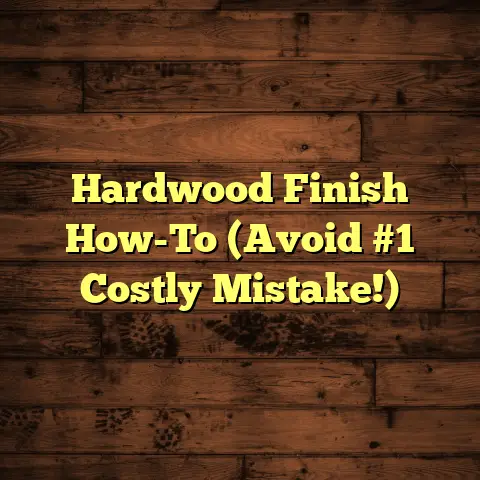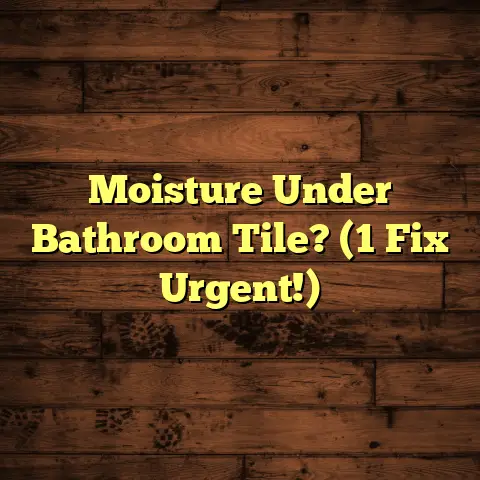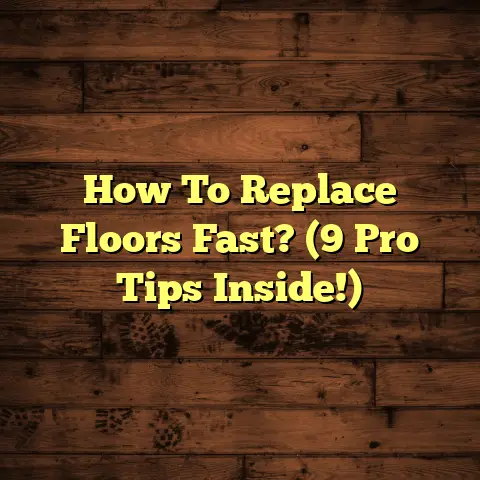Repairing Lifted Laminate Floor? (4 Steps to Fix!)
As a flooring contractor, I know how much you value a beautiful and functional home, especially when you’ve got furry friends running around.
Let’s face it, pets are family, but they can be tough on our floors!
I’ve seen it all – scratches, spills, and yes, even lifted laminate.
Don’t worry, though!
I’m here to walk you through the steps to repair lifted laminate flooring, focusing on how to tackle pet-related damage and choose more durable options.
Understanding Lifted Laminate Flooring
So, what exactly is lifted laminate flooring?
It’s when the edges or sections of your laminate planks start to come up, creating unsightly gaps or even tripping hazards.
I often see this issue pop up, and it’s usually due to a few common culprits:
-
Pet Activities: Scratching, accidents (we’re talking pee!), and constant foot traffic from your energetic companions can wear down the flooring.
-
Humidity and Temperature Changes: Laminate can expand and contract with fluctuations in humidity and temperature, leading to buckling and lifting.
I’ve seen this happen a lot, especially in bathrooms or basements.
In fact, according to the National Wood Flooring Association, maintaining a consistent humidity level between 30% and 50% can significantly reduce the risk of moisture-related flooring issues.
[National Wood Flooring Association]
-
Poor Installation: If the laminate wasn’t installed properly to begin with, it’s more likely to lift over time.
Things like inadequate expansion gaps or uneven subfloors can cause problems down the road.
Ignoring lifted flooring is a bad idea.
It can lead to further damage, like broken planks or a compromised subfloor.
Plus, it’s a safety hazard, especially for kids and pets!
Pet-Friendly Flooring Choices
Okay, so how do you prevent this whole lifting laminate nightmare in the first place?
The answer is simple: choose pet-friendly flooring!
When selecting laminate, look for these features:
-
Scratch Resistance: Opt for laminate with a durable wear layer that can withstand those playful claws.
Manufacturers often use an AC (Abrasion Class) rating to indicate scratch resistance.
I recommend looking for AC3 or higher for homes with pets.
-
Water-Resistant or Waterproof Options: Accidents happen!
Water-resistant laminate can handle minor spills, while waterproof options are ideal for areas prone to moisture.
Keep in mind that “water-resistant” and “waterproof” aren’t the same.
Waterproof laminate typically has a tighter locking system and a core material that won’t absorb water.
-
Easy-to-Clean Surfaces: Look for laminate with a smooth, non-porous surface that’s easy to wipe clean.
Trust me, you’ll thank me later!
There are some brands that I often recommend to my clients because of their durability and pet-friendliness.
For example, Pergo offers a line of laminate flooring specifically designed to resist scratches, stains, and moisture.
Armstrong Flooring also has some great options with enhanced scratch and stain protection.
Tools and Materials Needed for Repair
Alright, let’s get down to business.
Here’s what you’ll need to repair that lifted laminate:
-
Pry Bar or Flathead Screwdriver: For gently lifting the damaged plank.
-
Wood Glue or Flooring Adhesive: To re-secure the plank to the subfloor.
I prefer using a high-quality flooring adhesive that’s specifically designed for laminate.
-
Hammer: For tapping the plank into place.
-
Tapping Block or Mallet: To protect the laminate from damage while hammering.
-
Utility Knife: For scoring the plank if needed.
-
Moisture Meter (Optional): To check the moisture level of the subfloor.
You can find these tools at most hardware stores, like Home Depot or Lowe’s.
You can also order them online from retailers like Amazon.
Step-by-Step Guide to Repairing Lifted
Laminate Flooring
Okay, let’s get started!
Step 1: Identify the Problem Area
First things first, you need to locate all the lifted sections of your laminate floor.
Run your hand over the floor and feel for any uneven areas or gaps.
Pay close attention to areas where your pets frequent, like near their food bowls or sleeping spots.
Once you’ve found the lifted areas, assess the extent of the damage.
Is it just a small section that’s lifting, or is it a larger area?
Also, check for any signs of moisture, like discoloration or a musty smell.
If you suspect moisture, use a moisture meter to check the subfloor.
A reading above 12% indicates a moisture problem that needs to be addressed before repairing the laminate.
Step 2: Remove the Lifted Laminate Plank
Now, carefully remove the lifted plank(s).
This can be a bit tricky, especially with interlocking laminate systems.
Start by using a pry bar or flathead screwdriver to gently lift the edge of the plank.
Be careful not to damage the surrounding planks.
If the plank is difficult to remove, try scoring the edges with a utility knife to break the adhesive bond.
For interlocking systems, you may need to gently tap the plank with a tapping block and hammer to disengage the locking mechanism.
Once the plank is loose, carefully lift it out of the floor.
Step 3: Prepare the Subfloor
With the lifted plank removed, it’s time to inspect the subfloor.
Look for any signs of moisture, damage, or unevenness.
If you find any moisture, allow the subfloor to dry completely before proceeding.
You can use a dehumidifier or fan to speed up the drying process.
If the subfloor is damaged, you may need to repair it before reinstalling the laminate.
This could involve patching any holes or cracks with a concrete patching compound or replacing damaged sections of the subfloor.
Before reinstalling the laminate, make sure the subfloor is clean and free of debris.
Vacuum or sweep the area thoroughly.
Step 4: Reinstall the Laminate Plank
Now for the final step: reinstalling the laminate plank!
Apply a thin, even layer of wood glue or flooring adhesive to the back of the plank.
Be sure to use an adhesive that’s specifically designed for laminate flooring.
Carefully position the plank back into place, aligning it with the surrounding planks.
If you’re working with an interlocking system, make sure the locking mechanism is properly engaged.
Use a tapping block and hammer to gently tap the plank into place, ensuring a snug fit.
Wipe away any excess adhesive with a damp cloth.
Once the plank is in place, check for proper alignment with the neighboring planks.
You want to make sure there are no gaps or uneven edges.
Allow the adhesive to cure fully before placing any furniture back on the floor.
Check the adhesive manufacturer’s instructions for recommended drying times.
Conclusion
So, there you have it!
Repairing lifted laminate flooring can be a DIY-friendly project with the right tools and knowledge.
Remember, choosing pet-friendly flooring options is key to preventing future issues.
And don’t forget to address any moisture problems promptly to protect your floors from damage.
By taking a proactive approach to maintaining your laminate flooring, you can keep your home looking beautiful and functional for years to come, even with your beloved pets running around!





